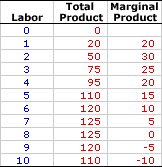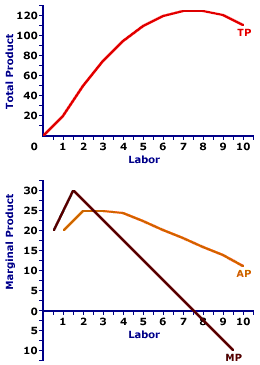
|
|
FLOW: A variable or measurement that is defined for a period of time (as opposed to an instant in time). A flow can only be measured over a period. For example, GDP is the flow of production during a given year. Income is another flow measures important to the study of economics.
Visit the GLOSS*arama
|
|


|

|
                           LAW OF DIMINISHING MARGINAL RETURNS: A principle of short-run production stating that as a firm combines more of a variable input with a fixed input, the marginal product of the variable input eventually declines. This is THE economic principle underlying the analysis of short-run production for a firm. It offers an explanation for the law of supply and the positive slope of the market supply curve. The law of diminishing marginal returns means that the productivity of a variable input declines as more is used in short-run production, holding one or more inputs fixed. This law has a direct bearing on market supply, the supply price, and the law of supply. If the productivity of a variable input declines, then more is needed to produce a given quantity of output, which means the cost of production increases, and a higher supply price is needed. The direct relation between price and quantity produced is the essence of the law of supply.A Few Numbers| Making Tacos |  |
To illustrate this important law, consider the production of Super Deluxe TexMex Gargantuan Tacos (with sour cream and jalapeno peppers). The table to the right presents the hourly production of Gargantuan Tacos as Waldo's TexMex Taco World employs different quantities of labor, the key variable input for short-run taco production. The first column is the number of workers, the second is the total hourly production of Gargantuan Tacos and the third column is the marginal product generated by each additional worker.For the first two workers marginal product actually increases. This reflects increasing marginal returns and commonly results when the variable input is able to make increasingly effective use of a given fixed input. For the third worker on, however, marginal product decreases. This reflects decreasing marginal returns and the law of diminishing marginal returns. The marginal product of the third worker is 25 tacos, compared to 30 tacos for the second worker. The marginal product of the fourth worker then declines to 20 tacos. For the fifth worker, the marginal product falls to 15. For each subsequent worker, the marginal product declines. Marginal product eventually reaches zero for the eighth worker and even declines for the ninth and tenth workers. The decreasing values of marginal product exhibited for taco production by Waldo's TexMex Taco World reflect the law of diminishing marginal returns. Why It WorksThe primary reason the marginal product of this variable input declines is the fixed input. The fixed input imposes a capacity constraint on short-run production. In this taco production example, the size of the taco-producing kitchen is fixed. The amount of taco-producing equipment and utensils are fixed. As Waldo's TexMex Taco World employs additional workers, the kitchen becomes increasingly crowded. Only so many workers can use the taco-preparation counter to prepare tacos. Only so many workers can use the lettuce-chopping block to chop lettuce. Only so many workers can use the stove to cook the taco meat.While adding additional workers can and do increase total taco production, the extra production attributable to these workers is bound to fall as the capacity of the fixed input is approached. In fact, adding too many workers--that is, the ninth and tenth workers--actually results in a negative marginal product, meaning total product decreases. Nine workers produce less than eight workers. And ten workers produce even less than nine. The marginal products of the ninth and tenth workers are negative. Marginal ReturnsHow does the law of diminishing marginal returns assist in an understanding of supply? The law of supply and the upward-sloping supply curve indicate that a firm needs to receive higher prices to produce and sell larger quantities. Higher prices are required because production cost is greater, which occurs because the productivity of the variable input (that is, marginal product) is less.Suppose, for example, that one worker can produce 15 units of output, but due to the law of diminishing marginal returns, the next two workers can produce 10 and 5 units of output, respectively. Because these subsequent workers are less productive, the firm needs both to produce the same output as the other. This means the cost is twice as much and the firm needs to charge twice the price. Because the law of diminishing marginal returns causes a decline in input productivity, additional production requires more inputs at a higher cost per unit or output produced. To produce and supply larger quantities, higher prices are needed. Three Product Curves| Three Curves |  |
The law of diminishing marginal returns is reflected in the shapes and slopes of the total product, marginal product, and average product curves. The most important of these being the negative slope of the marginal product curve.This graph presents the three product curves that form the foundation of short-run production analysis. - Total Product Curve: The curve labeled TP in the top panel is the total product curve, the total number of TexMex Gargantuan Tacos produced per hour for a given amount of labor. Click the [TP] button to highlight this curve. The increasingly flatter slope of the TP is attributable to the law of diminishing marginal returns.
- Marginal Product Curve: The MP curve is the marginal product curve. Click the [MP] button to highlight this curve. The MP curve indicates how the total production of TexMex Gargantuan Tacos changes when an extra worker is hired. The negatively-sloped portion of the MP curve is a direct embodiment of the law of diminishing marginal returns.
- Average Product Curve: The average product curve, labeled AP, indicates the average number of TexMex Gargantuan Tacos produced by Waldo's workers. Click the [AP] button to highlight this curve. The negatively-sloped portion of the AP curve is indirectly caused by the law of diminishing marginal returns. As marginal product declines, due to the law of diminishing marginal returns, it also causes a decrease in average product.
The Law of SupplyWhile the law of diminishing marginal returns pops up throughout the study of economics, it is essential to an understanding of supply and the law of supply. It provides a bit of key insight into the question: "Why does the supply curve have a positive slope?"The essence of this explanation is that the supply price that sellers are willing and able to receive for a good depends on the production cost. If the production cost increases, then the sellers need a higher supply price. Because the marginal product of a variable input declines with greater production, more of the variable input is needed, which increases production cost. This law of diminishing marginal returns is the counterpart of the law of diminishing marginal utility. As the law of diminishing marginal utility offers an explanation for the law of demand and the negative slope of the demand curve, the law of diminishing marginal returns offers an explanation for the law of supply and the positive slope of the supply curve.

Recommended Citation:LAW OF DIMINISHING MARGINAL RETURNS, AmosWEB Encyclonomic WEB*pedia, http://www.AmosWEB.com, AmosWEB LLC, 2000-2025. [Accessed: July 9, 2025].
Check Out These Related Terms... | | | | | | | |
Or For A Little Background... | | | | | | | | | | | | | | | | | | | | | | | |
And For Further Study... | | | | | | | | |
Search Again?
Back to the WEB*pedia
|



|

|
BLACK DISMALAPOD
[What's This?]
Today, you are likely to spend a great deal of time flipping through mail order catalogs trying to buy either 500 feet of coaxial cable or a coffee cup commemorating the 1960 Presidential election. Be on the lookout for telephone calls from former employers.
Your Complete Scope
This isn't me! What am I?
|

|
|
The earliest known use of paper currency was about 1270 in China during the rule of Kubla Khan.
|

|
|
"All labor that uplifts humanity has dignity and importance and should be undertaken with painstaking excellence. " -- Martin Luther King Jr., civil rights leader
|

|
GNMA
Government National Mortgage Association
|

|
|
Tell us what you think about AmosWEB. Like what you see? Have suggestions for improvements? Let us know. Click the User Feedback link.
User Feedback
|


|


